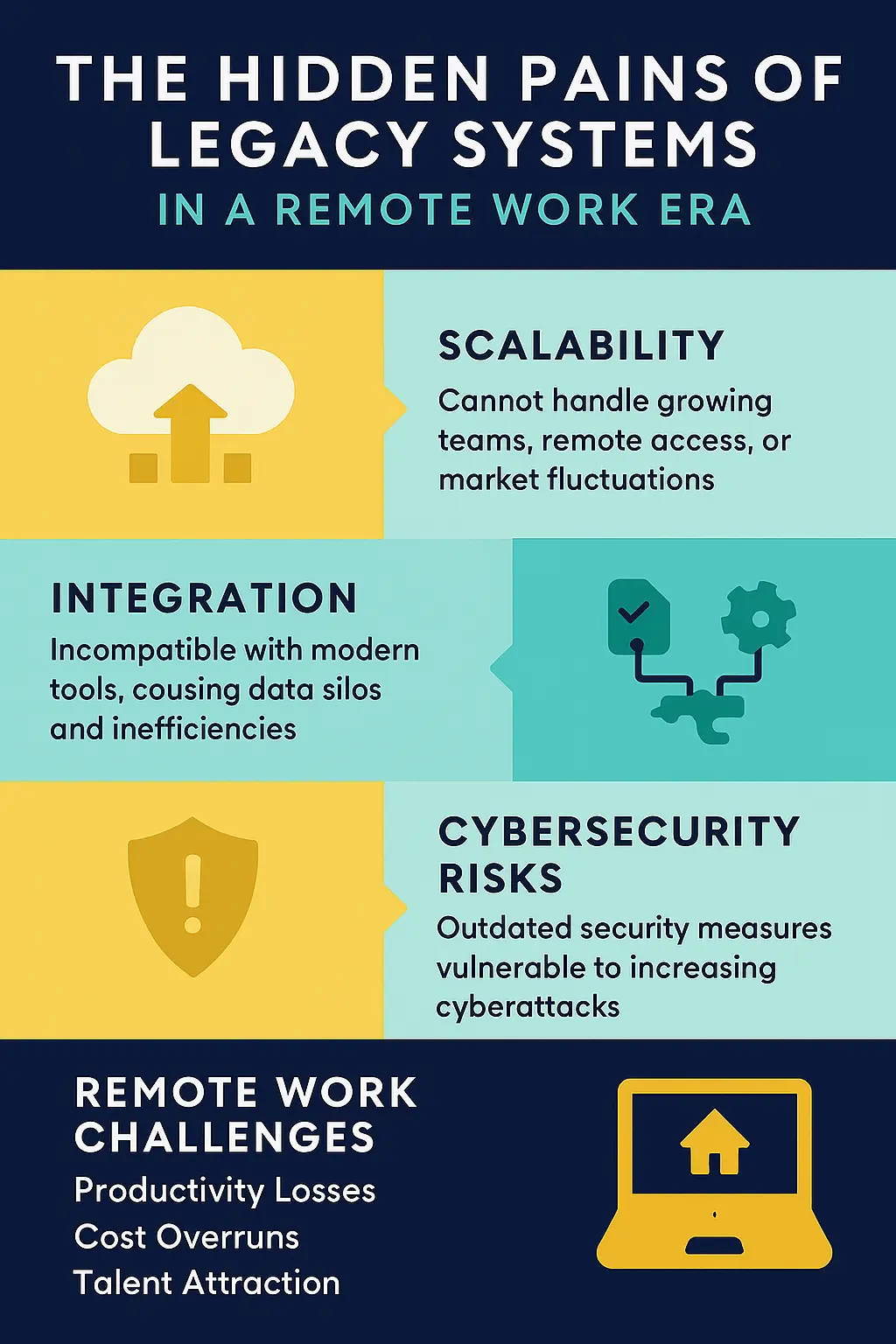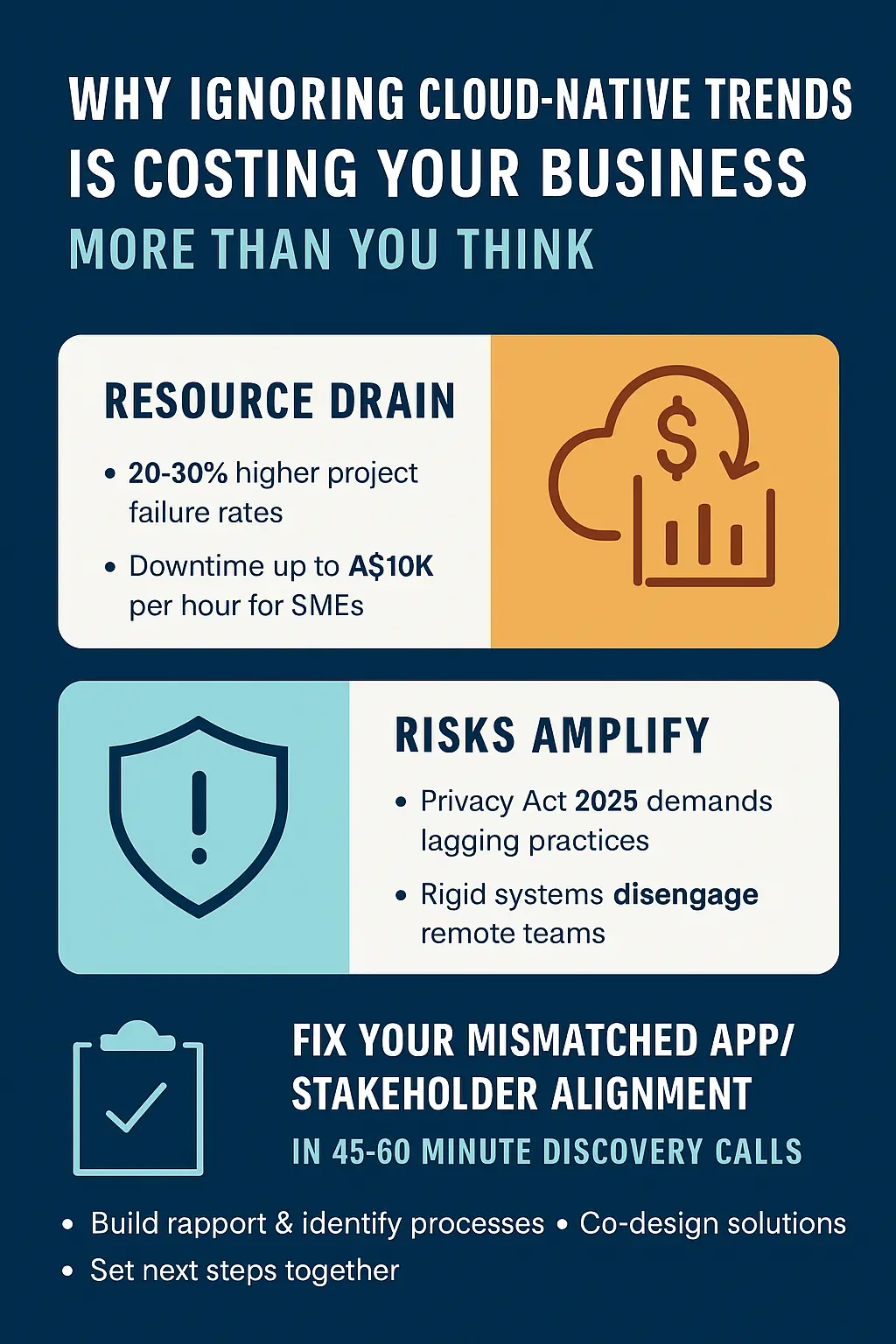As a Melbourne-based business owner or executive, you're no doubt feeling the pressure of a rapidly evolving digital landscape. Legacy systems—those outdated, on-premise setups that once served your organisation well—are now creaking under the weight of modern demands. With remote work persisting well into 2025, teams scattered across suburbs like South Yarra, Docklands, and beyond are struggling with slow access, limited scalability, and integration headaches that sap productivity and inflate costs. Imagine your sales team in Richmond unable to collaborate seamlessly on a deal because the CRM system lags during peak hours, or your finance department in the CBD facing downtime that costs thousands per hour. These aren't hypothetical scenarios; they're the daily realities for many Australian organisations still tethered to pre-pandemic infrastructure.
The persistence of remote work in Australia exacerbates these issues. Recent statistics show that 36% of Australians work from home partly or entirely, with major cities like Melbourne seeing over 50% of workers adopting hybrid models. This shift, accelerated by the COVID-19 pandemic, has made flexible, accessible systems non-negotiable. Yet, many businesses are lagging, leading to inefficiencies that could cost the economy billions. Deloitte's Cloud Imperative report highlights this urgency, noting that only 7% of Asia Pacific organisations (including Australia) have not adopted cloud, with 72% of leaders citing operational efficiency as a top benefit. Projections indicate over 80% of Australian businesses are using or planning cloud migrations by 2026, boosting demand for custom integrations to handle this transition smoothly.
Enter the cloud revolution sweeping Melbourne's tech scene. Cloud-native development—building software specifically for cloud environments using platforms like AWS, Google Cloud, and Microsoft Azure—is emerging as the solution. Influenced by local heavyweights like Atlassian, which has shaped Australian practices through its cloud migrations and AI integrations, this approach promises scalability and resilience. But rushing in without proper planning can amplify problems rather than solve them. That's where C9, Australia's leading custom software, apps, integration, and database developer, comes in. Specialising in custom software development in Melbourne, we help executives like you navigate this shift. In this guide, we'll explore the pains of clinging to legacy tech, agitate the risks of inaction, and present tailored solutions— all framed around why skipping discovery calls is a recipe for disaster and how staged projects deliver early ROI.
The Hidden Pains of Legacy Systems in a Remote Work Era

The pains start with scalability—or the lack thereof. Traditional systems require hefty upfront investments in hardware, which become bottlenecks as your team grows or demand fluctuates. In Melbourne's dynamic market, where the software development sector is projected to grow at a CAGR of 18.7% from 2025 to 2033, reaching USD 17.15 billion nationally, businesses can't afford rigidity. Remote work amplifies this: With 51% of Melbourne workers operating from home at least part-time, systems must support seamless access without VPN slowdowns or security lapses.
Integration challenges compound the issue. Legacy software often doesn't play well with modern tools, leading to siloed data and manual workarounds. For instance, a Melbourne retailer might struggle to sync inventory across e-commerce platforms, resulting in lost sales during busy periods like the Australian Open influx. Cybersecurity risks loom large too, with Australia's Notifiable Data Breaches scheme reporting rising incidents—legacy systems are prime targets.
Cloud-native trends address these head-on. Building for cloud environments means using microservices, containers (like Docker), and orchestration tools (e.g., Kubernetes) on AWS, Azure, or Google Cloud. AWS offers Amazon EKS for managed Kubernetes, enabling auto-scaling; Azure's AKS supports hybrid setups for data sovereignty; Google Cloud's Anthos facilitates multi-cloud management. In Melbourne, events like the Cloud Native Development Summit 2025 highlight these, with communities like Cloud Native Melbourne fostering innovation.
Atlassian's influence is palpable. As Australia's top tech brand valued at USD 3.8 billion, its cloud-native migrations (e.g., Bitbucket to public cloud) inspire local firms, especially in Melbourne's ecosystem supported by LaunchVic. Yet, without addressing these pains, organisations risk falling behind.
Remote Work Challenges in Detail:
- Productivity Losses: Delays in access can cost hours weekly; 72% of remote workers report better efficiency with cloud tools.
- Cost Overruns: On-premise maintenance eats budgets; cloud shifts could save A$13.5 billion for government alone by 2035.
- Talent Attraction: Melbourne's IT market demands AI and cloud skills; hybrid work is key for retention.
Why Ignoring Cloud-Native Trends is Costing Your Business More Than You Think

If the pains weren't enough, let's agitate the consequences of inaction. Delaying cloud migration isn't just status quo—it's a competitive death knell. Gartner forecasts Australian IT spending at A$172.3 billion in 2026, up 8.9%, with software leading at 13.6% growth to A$60 billion. Organisations stuck on legacy tech face 20-30% higher failure rates in projects, with downtime costing up to A$10,000 per hour for mid-sized firms.
Remote work persistence intensifies this: With 20% of South Australian employers mandating full office returns, but Melbourne favouring flexibility (52% WFH), mismatched systems lead to disengaged teams. Compliance risks under the Privacy Act 2025 reforms add layers of complexity, potentially fines for data breaches.
Skipping discovery calls is the worst idea here. These aren't sales pitches; they're 45-60 minute sessions to uncover needs, reducing risks by 30% and aligning stakeholders. Without them, projects misalign, leading to scope creep and overruns. Breakdown: (1) Alignment (15 mins), (2) Pain deep-dive (20 mins), (3) Brainstorming (10 mins), (4) Next steps (10 mins). Far from a waste, they optimise budgets and ensure user-centric outcomes.
Example: A Melbourne logistics firm ignored discovery, building a mismatched app—resulting in rework costing 25% extra. Agitating further: In a market where custom software in Australia grows at 25.1% CAGR to A$3.7 billion by 2030, laggards lose market share.
Unlocking Efficiency with Cloud-Native Solutions from C9
Now for the solution: C9's expertise in custom software development in Melbourne turns these pains into gains. We specialise in cloud-native builds on AWS, Azure, and Google Cloud, delivering scalable, secure integrations tailored to your needs.
How it works: We use microservices for modularity, serverless for cost-efficiency (pay-per-use), and hybrid models for compliance. For a finance client, we migrated to Azure Arc, extending on-premise control while enabling remote access—cutting costs by 20-40%. Drawing from Atlassian's AI-cloud synergies (e.g., modernising banks), we infuse intelligence for predictive analytics.
Discovery calls kickstart this, ensuring bespoke solutions. Our phased approach delivers quick wins: Phase 1 focuses on core migration for immediate ROI (e.g., 15% efficiency gains), funding further phases.
| Aspect |
Traditional Systems |
Cloud-Native with C9 |
| Scalability |
Hardware-limited |
Auto-scaling via AWS/Azure |
| Remote Access |
VPN-dependent |
Global, secure connectivity |
| Cost |
High maintenance |
20-40% savings long-term |
| Integration |
Manual |
Automated custom APIs |
| Time to Market |
Months |
Weeks with agile stages |
Navigating Pricing: The Dangers of Indicative Quotes and the Power of Discovery-Based Approaches
Before proposing any project, we insist on discovery—indicative pricing without it isn't worth the paper it's written on. Indicative quotes, based on assumptions, lack precision and ignore complexities like integrations or compliance, leading to scope creep and 50% overruns. They're rounded to the nearest day or week, inflating costs.
Discovery-based pricing refines post-analysis, billing to the hour for accuracy. Example: For a Melbourne e-commerce app migration, indicative might quote A$80,000 (8 weeks at A$10,000/week). Discovery reveals efficiencies (e.g., reusing Google Cloud modules), pricing at A$68,750 (275 hours at A$250/hour), saving A$11,250.
It uncovers needs, preventing mismatches. Highlight staging: Break into phases for early ROI—savings from Phase 1 (e.g., A$20,000 efficiency) fund improvements, minimising risk. ROI for software projects often hits 15-30%, with staged delivery boosting to 50% in high-performers.
| Pricing Type |
Method |
Example Calculation |
Pros/Cons |
| Indicative |
Nearest week |
10 weeks x A$8,000 = A$80,000 |
Quick but risky; +20% overruns |
| Discovery-Based |
Nearest hour |
320 hours x A$250 = A$80,000; refined to 275 = A$68,750 |
Precise; saves via discovery |
Embrace the Cloud Revolution with Confidence
Melbourne's cloud revolution offers immense potential for business owners and executives. By mastering cloud-native development with AWS, Azure, and Google Cloud, influenced by Atlassian and driven by remote work trends, you can achieve scalability, efficiency, and growth. C9's discovery-driven, staged approach ensures your custom software development in Melbourne delivers tangible ROI while avoiding common pitfalls.
Don't let legacy pains hold your organisation back. Schedule a free discovery call with C9 via our website or contact us. Unlock your cloud potential and thrive in Melbourne's tech boom—book now!
Key Citations